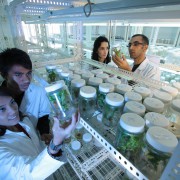
BACK TO OVERVIEW
JOINT AUSTRALIAN-GERMAN INNOVATION IN THE SECTORS ADVANCED MATERIALS & FUTURE CITIES
Australia has world class capabilities in materials sciences that are attracting the attention of the world’s leading manufacturers. Investors already include Boeing, GE, Lockheed Martin, Bombardier, Concept Laser, Microturbo, the European Space Agency, Baosteel and Chalco.
Boeing’s research partnership in the field of advanced materials with CSIRO (Commonwealth Scientific and Industrial Research Organisation) has lasted for more than 20 years. Many Australian companies with innovative technologies such as Ceramic Fuel Cells Limited, Quickstep Technologies and Plantic Technologies have entered into joint research and development projects with German companies before establishing in the German market, the homeland of engineering.
Home to four of the world’s 10 most livable cities Australia has much to offer the world in sustainable urban planning, energy efficiency, and climate change adaptation and mitigation. Collaboration in the field of Future Cities currently includes the Fraunhofer Morgenstadt Initiative, involving Brisbane as a role model for a tropical metropolis of the future. Joint research between Audi and the Royal Melbourne Institute of Technology (RMIT) GEELab is undertaking critical research on mobility solutions and future driving experiences to create smarter cities.
“Leading Australian and German researchers and corporates have joined forces to develop innovative, technology applications for the future, and to face the global challenges of our time. The projects presented at the Australia – Germany Innovation Forum are great examples of how scientific collaborations and strategic partnerships between our countries are delivering a future of innovation,” Nicola Watkinson, Australian Senior Trade and Investment Commissioner to Western Europe, Austrade, draws the conclusion of the Australia – Germany Innovation Forum.
The Australia – Germany Innovation Forum 2013 is the culmination of the 60th anniversary of diplomatic relations between Australia and Germany. Commemorated from 28 January 2012 to 28 January 2013 collaboration in science and innovation has been a focal point throughout the year.
This event highlighted the enduring research and investment linkages between the two leading economies and looked at how innovation and research collaboration can shape the next 60 years.
Further examples / business cases for Australian – German collaboration:
• Boeing’s partnership with the CSIRO of more than 20 years focused on research projects in space sciences, biofuels, advanced materials and other aircraft technology innovations.
• Carl Zeiss Vision’s Australian R&D centre is its first centre outside Germany
• Fuchs Lubricants continues to grow after 10 years in Australia, with the German company claiming a 10 per cent market share and its Australian operation is the fourth largest in the Fuchs group
• BASF, Germany’s leading chemical company, opened a R&D centre in Australia to lead technological innovation and increase productivity in the global mining and resources sector. It is also jointly involved in developing polymers to assist the agricultural industry.
• IBM has opened its first life sciences R&D laboratory in the world co-located at the University of Melbourne.
• GE has established a strategic R&D alliance with CSIRO to research innovation in health, water, aviation and clean energy carbon reduction technologies.
– Ricoh, leading Japanese photographic company, has established their Ricoh Innovation Centre in print technology in Australia
– British steel maker Corus is working with Australian company Dyesol on solar energy technology.
– Citrix Labs has two-thirds of its researchers based in Australia.
• Biotech giant Amgen rates Australia as one of the top medical study locations outside of the US.


